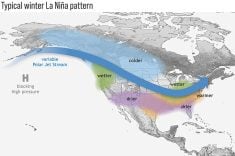Saskatchewan will be receiving the lion’s share of $175 million earmarked by the federal government for western Canadian roads as part of its new grain transportation legislation.
Each of the four western provinces will get $1.5 million, said Howard Migie, director general of Agriculture Canada’s policy branch.
Of the remaining $169 million, Saskatchewan will get a little more than 62 percent, Manitoba will receive 19 percent, Alberta’s share is 18 percent and 0.4 percent will go to British Columbia.
Migie said provincial share is based on the amount of grain-dependent branch lines in each province.
Read Also

Canadian Food Inspection Agency extends chronic wasting disease control program consultation deadline
Date extended for consultation period of changes to CWD program
The Saskatchewan government will spend $35 million a year over the next five years mainly on municipal roads. Some money may be devoted to secondary highways attached to those roads. None of the money will be spent on primary highways.
The money is available under the rail transportation reforms recently announced. Ottawa will begin dispersing the money to the provinces on April 1, 2001.
Most farm groups say the $175 million is good news, even though they insist it isn’t enough.
The Saskatchewan Canola Growers Association said $35 million will only buy 800 kilometres of road each year.
Keystone Agricultural Producers said the amount is far from sufficient to address the problem of deteriorating highways in Western Canada.
The National Farmers Union said the money represents a fraction of the increased road costs expected as railways abandon branch lines.
But Migie contends that the money was never meant to be a panacea. He said federal policies are only partially responsible for the shift of grain traffic from railways to roads.
“This is not meant to cover the entire need in terms of road impact.”
Migie said the removal of the Crow Benefit contributed to an industry trend toward using trucks instead of railways to transport grain on short-haul trips. He said elevator consolidation and more processing facilities on the Prairies have also led to an increase in trucking.
Mike Woods, director of communications with Saskatchewan Highways, said road damage due to heavy hauling in the province amounts to $65 million a year. He said the province’s share of the federal funds – $21 million a year – will help but won’t solve the deterioration of the province’s road network.
Woods said the cost of repaving one kilometre of highway is about $150,000 and the cost to repair one kilometre of secondary highway is $3,200.
The cost of building a new road from scratch is $250,000 per kilometre for single-lane highways and $500,000 per kilometre for twin highways.
The province will spend $180 million on highway maintenance and new road construction this year.
“It’s an expensive business.”
Migie said many details of the road program have to be ironed out between the federal government and the western provinces. But when it comes to approving expenditures on municipal road projects, he would like all provinces to adopt a system similar to the one that has been used in Saskatchewan where the municipalities propose projects and a committee ranks them based on a set of criteria.
“We’re going to try that model out as a basis for negotiations with each of the four provinces.”















